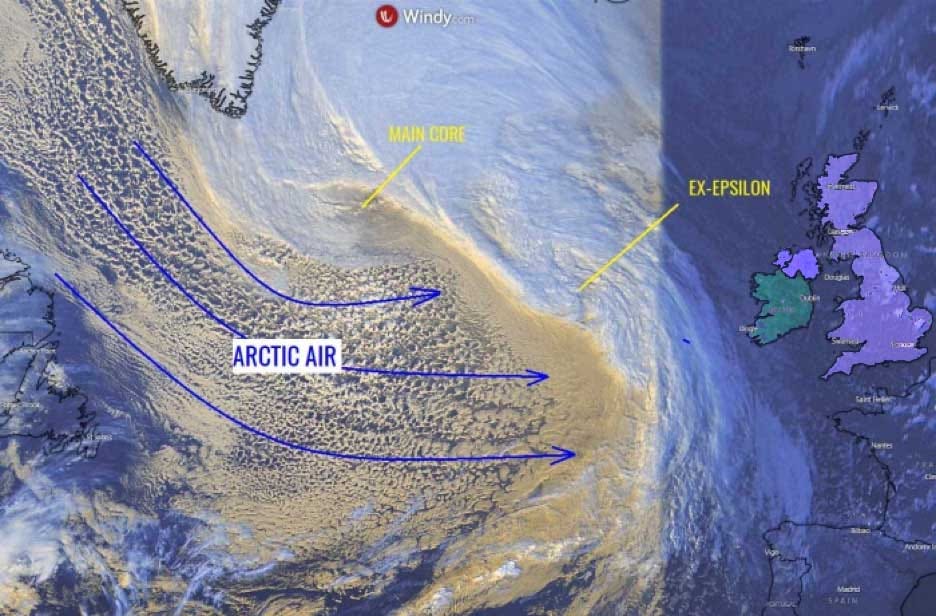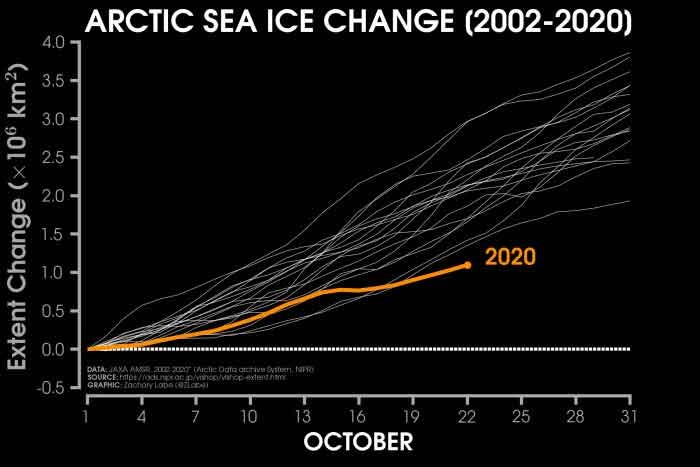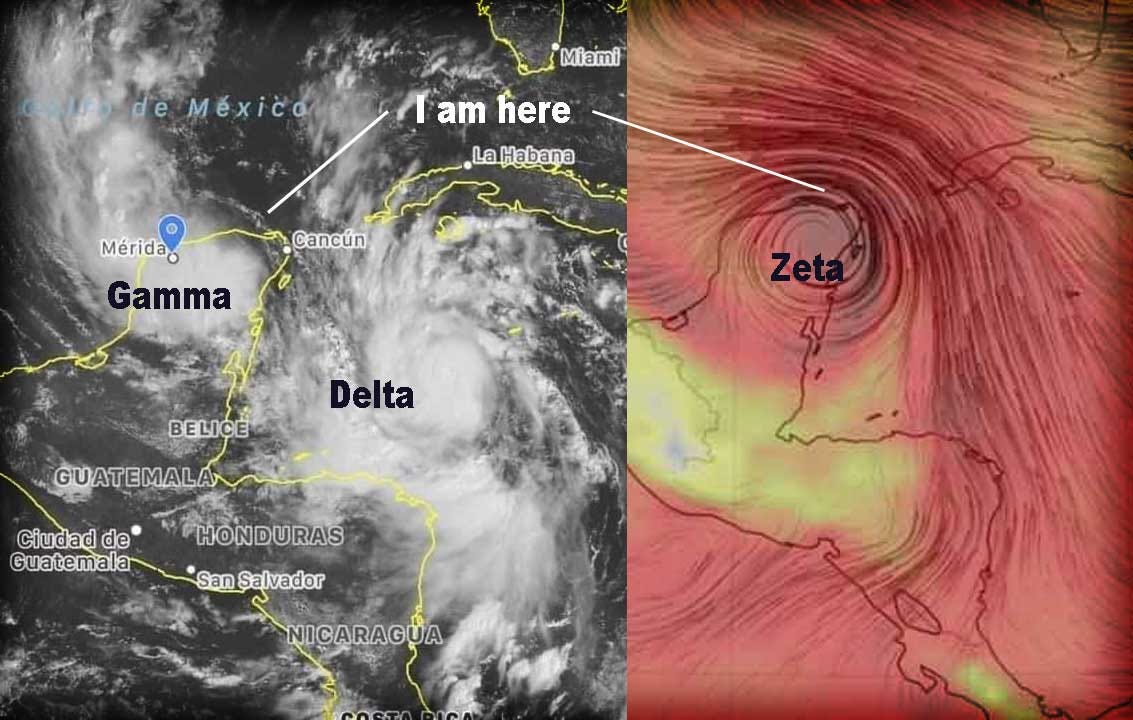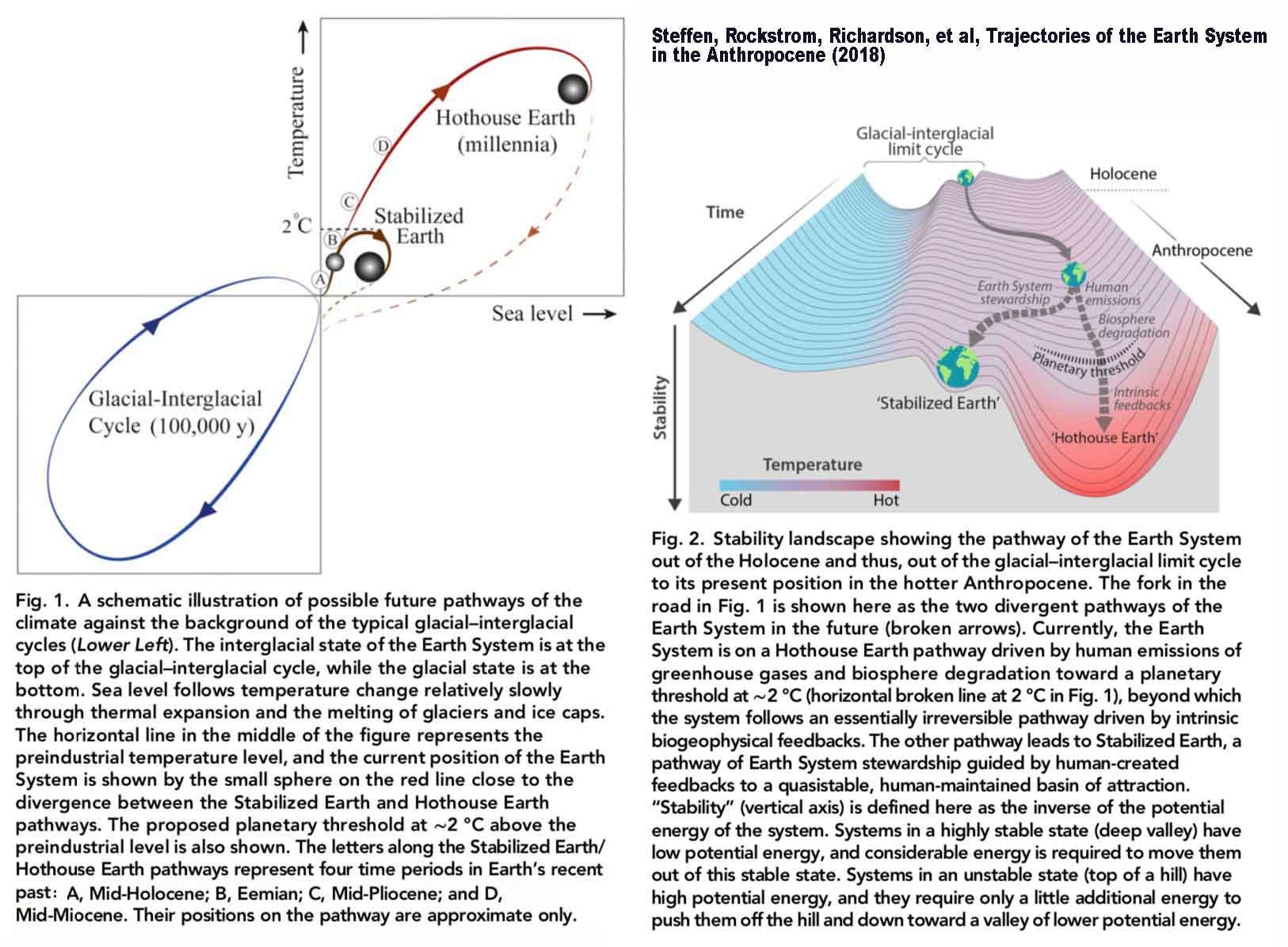The Great Pause Week 33: Explosive Cyclogenesis
"Biophysical inertia, technological lock in, and the socioeconomic addictions we hear parroted in the speeches of our political candidates condemn us to this self-inflicted fate. "
From a thatched palapa here I have been watching the weirding of the weather—a viral phenomenon of a different sort. At this writing, Las Vegas has seen 198 consecutive days without rain. Parts of California have gone 204 days. In October temperatures across half of the USA dropped to 40 degrees below normal. Thousands of birds were found dead throughout the western United States due to the weather. The year also saw record wildfires and devastating droughts, landslides from heavy rains, and new dust bowls. In late October Colorado firefighters were battling the largest blaze in state history amidst swirling ash and… snow.
For the past four billion years, Earth has been producing unique lifeforms. Probably it will continue doing that until the rock on which we stand is drawn closer to the collapsing star it circles. Six times in that great span there have been extinction events. Life was pared back to something simpler. Eventually, conditions recovered and the process of evolutionary expansion resumed. We are in the sixth event now. We do not yet know if there will be any recovery this time. We still have agency and for better or worse our agency grows more powerful by the year.
Over the past 1.2 million years (a.k.a the Late Quaternary), Earth’s surface temperature rose and fell as ice ages waxed and waned. Not every cycle followed precisely the same pattern but they were broadly similar, until now. We won’t be experiencing the old cycle again for quite some time, probably millions of years. We have pushed the hot extreme to a new high mark and the cold extreme is unknown — likely much warmer; potentially a habitable cool; possibly not. We are conducting a large biogeophysical experiment with no predetermined outcome.
One summer evening a year or two ago, ecosystem regenerate John D. Liu leaned over our table in a cafe in Covent Garden to show me a ground-penetrating radar view of ancient watercourses in the Arabian Peninsula. Pointing to a geological lake bed at the edge of the Eastern Mediterranean, he described how all the freshwater drainage of the Peninsula had converged.
After a few thousand years tilling most fertility out of the lush savannas of the Levant and felling the cedars of Lebanon, formerly migratory, now stationary, bipedal mammals had begun changing the climate of Earth. The Arabian Peninsula and Fertile Crescent desertified, and when that happened, the winds flowing eastward across the Mediterranean reversed direction. Where once there had been reliable monsoons to re-wet the area from Ash Sharqia to the Zagros, now the winds drained down from the mountains of present-day Armenia and Azerbaijan and flowed towards the Atlantic. The wind change created a reinforcing feedback. Desertification accelerated.
The Anthropocene had started.
However, because the orbit and tilt of the Earth predisposed us to glaciation every hundred millennia, the tools of early humans merely countered natural cooling trends. We stabilized into a geological epoch, the Holocene, that would be the envy of Goldilocks. Not too hot, not too cold, just perfect for the expansion of a warm-blooded, fecund, mammalian species.
The reforestation of Europe brought about by the Mongol Invasion from 1220 CE (~700 megatons of CO2 drawdown) and of the Americas in the Columbian Encounter (~10 gigatons of CO2 drawdown) were minor perturbations compared to the Industrial Revolution. Now we melt ice in the Arctic and change the net reflectivity (albedo) of the planet. The darker ocean stores more heat, and that in turn changes the way the polar vortex — the circulation of air contra to the spin of the planet — moves. The stream meanders. The October blizzards and freezes just experienced across half of North America were a southward dip of the vortex. Drought and wildfires break out when the river of air swings north.
In late October I sat quietly at the desk in my one room palapa watching the approach of Zeta via earth.nullschool.net. I had only just returned to the island from the mandatory evacuation for Hurricanes Gamma/Delta but remained for Zeta because there was simply not enough time to evacuate safely, given how quickly it developed. Zeta was the seventh Atlantic storm since July to hit the meteorologists’ definition for rapid intensification. The term coined by climatologists is “explosive cyclogenesis.”
But really, Zeta’s cyclogenesis started 130,000 years ago in the Western Levant, when we sedimented in that giant lake, using irrigation and the plow. Today the wind that blows across the Sahara carries tiny bits of sand, some of them the memories of ancient fortresses, temples and granaries. Those grains become seed kernels of raindrops, clouds that drift west along the Tropic of Cancer until they encounter warmer water in the mid-ocean doldrums and assume a counterclockwise cyclonic motion in the Eastern Caribbean. That is how most Atlantic Hurricanes reach my island.
Sometimes the waters of the Central Atlantic become so warm that hurricanes will form spontaneously without taking days and weeks to cross an ocean. On October 15, 2005, an unusually large, monsoon-like circulation organized itself into a tropical cyclone east-southeast of Grand Cayman, in the Western Caribbean. In the span of just 24 hours, Hurricane Wilma intensified from a 60-knot gale to a 160-knot category 5 hurricane, a then unprecedented event and the origin of “explosive cyclogenesis.” When Wilma made landfall on October 22 it dumped 62 inches of rain on Mexican coastal cities and collapsed many beachfront hotels.
In 1988, I asked M.I.T. meteorologist Kerry Emanuel, whose interests tilted towards hurricane events, whether climate change would increase the frequency, not just the power, of 21st century hurricanes. He didn’t think so. I thought he was wrong but kept it to myself.
On November 1, Eta, the 28th named storm of 2020, tripled in strength in just over a day, explosively intensifying from 40-mph gusts Sunday morning to sustained winds of 120 mph Monday and 150 mph on Tuesday—only 5 mph shy of Category 5. A couple weeks ago, Gamma produced Category 1 winds and even as the rain fell, we learned about Delta taking shape and undergoing explosive cyclogenesis to Category 4, tracking directly in Gamma’s wake. With almost no advance warning, I had less than a day to secure everything and get off the island before Delta arrived. When I returned a week later, I cleared pieces of some distant neighbors’ roofing tiles from the path to my door, counted the dead amongst plants and wildlife, and removed spoiled food from the fridge to the soggy compost. Then explosive cyclogenesis replayed, not once, but twice more. Eta tied the 2005 record for named storms and the season runs until Nov. 30.
Last year I elevated my floor above the then-risen Atlantic waterline and this year I changed my roof from thatch to biochar ferrocement. There are other improvements needed, but at least, for now, I seem to be keeping pace. In UN-speak its called “adaptation.”
Away in the Arctic, things appear to be speeding up. I experienced Gamma, Delta and then Zeta, but Epsilon swung north before it reached my part of the ocean. Epsilon “transitioned” to a North Atlantic “extratropical cyclone” before reigniting into a zombie hurricane.Arctic Sea ice is not refreezing in October for the first time since measurements began. The warming of the Arctic slows the jet stream and lets it meander. On October 26, Epsilon’s remnants in the North Atlantic merged with an extratropical storm south of Iceland, absorbing each other into something unfathomably humongous that pounded Ireland, Northern Ireland, and Scotland with 9–12 meter (30–38 feet) waves. Fortunately for much of Northern Europe, wind shear broke Epsilon apart before it went any farther. |
The broad channel of arctic air imaged by satellite folded into the two merging cores |
Possibly one or more “sting jets” could develop. A sting jet is a relatively localized jet of rapidly descending cold air inside a deep extratropical cyclone. It affects a small region, compared to the size of the cyclone, and lasts only several hours, but can wield tornado-strength winds in excess of 160 km/h.
Fortunately for much of Northern Europe, a steering high from the Azores will push Zombie Epsilon north until wind shear breaks it apart.
 |
Banksy, Show Me The Monet |
Antarctic sea ice loss is now irreversible because of heat accumulation in the Southern Ocean. Felled forest conversion to grassland augurs warmer soils, increasing microbial respiration, releasing CO2 and methane at greater rates. Ocean methane hydrates bubbling to the surface decompose a million years of microbial and abiogenic exhalations in every summer season. Peat and permafrost carbon that require millennia to regenerate can burn away in hours. Fires release more carbon from soils than from burnt trees and it won’t be replaced in a few seasons, or even a few centuries.
As the Arctic heats up, it raises sea levels in Miami and Bangladesh and every other coastal city in the world, and it increases the odds of wildfires in California and the west. In a sense, the massive changes that are taking place in the Arctic are remaking the weather in America and northern Europe, with profound implications for everyone who lives there, whether they know it or not.
— Jeff Goodell, Rolling Stone, 2018
The future all these signs portend was represented in Figs. 1 and 2 of the PNAS paper by Steffen, Rockstrom, Richardson, et al, Trajectories of the Earth System in the Anthropocene (2018). Beyond a planetary stability threshold, intrinsic biogeophysical feedbacks control the dice. At 2°C the dice get loaded by tipping elements that raise the temperature further, increasing the likelihood of further tipping elements joining in. The game switches from dice to dominoes. Even if the Paris target of a 1.5 °C to 2.0 °C rise in temperature is met, a cascade of feedbacks can push Earth onto a “Hothouse” pathway.
There are, even now, ways back, and cascades that accelerate the return. There are good people showing the way, including John D. Liu. Ecosystems can be regenerated. The tools nature provides are still functioning. But we will need to perform repairs while adapting to changed conditions. I write this having just experienced a third explosive cyclogenesis in the Western Caribbean in a single month. I’m adapting.
For human civilization as a whole, we will not have a lot more time to make changes.
_____________________
 Help me get my blog posted every week. All Patreon donations and Blogger subscriptions are needed and welcomed. You are how we make this happen. Your contributions are being made to Global Village Institute, a tax-deductible 501(c)(3) charity. PowerUp! donors on Patreon get an autographed book off each first press run. My latest book, Plagued, is out now. A children’s version of Dark Side of the Ocean called Making Waves, may be out by Christmas. Please help if you can.
Help me get my blog posted every week. All Patreon donations and Blogger subscriptions are needed and welcomed. You are how we make this happen. Your contributions are being made to Global Village Institute, a tax-deductible 501(c)(3) charity. PowerUp! donors on Patreon get an autographed book off each first press run. My latest book, Plagued, is out now. A children’s version of Dark Side of the Ocean called Making Waves, may be out by Christmas. Please help if you can.







Comments
Was discussing Teilhard de Chardin's Phenomenon of Man with a good friend this weekend,
look up noogenesis and noocenosis for a topic to riff on here in a future essay!
wikipedia: an artificial biological community (biocenosis) built upon a degraded ecosystem. A noocenosis is the result of structural improvements by man and differs from the original, evolutionarily constructed biological community.
Could have some relevance to the question of where we'll going to make that fatal last wrong turn!
See
https://www.peakprosperity.com/the-coming-great-reset/
"The strategy is clear; use the anxiety about Covid to introduce a sweeping set of reforms. This is exactly what happened after 9/11 too, and what we got then was an endless war on a noun (terror) and a massive dismantling of civil liberties and a complete loss of personal privacy."